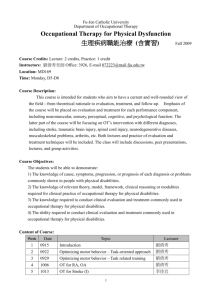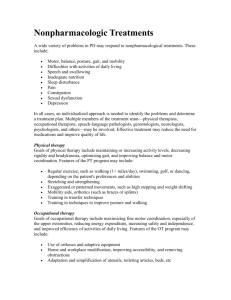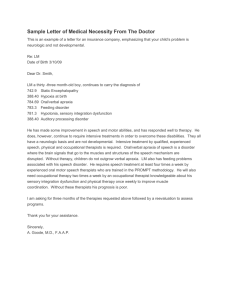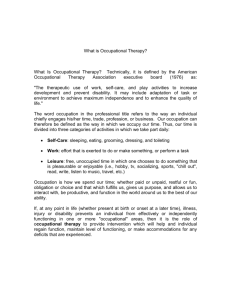Occupational Therapy for Physical Disabilities
advertisement
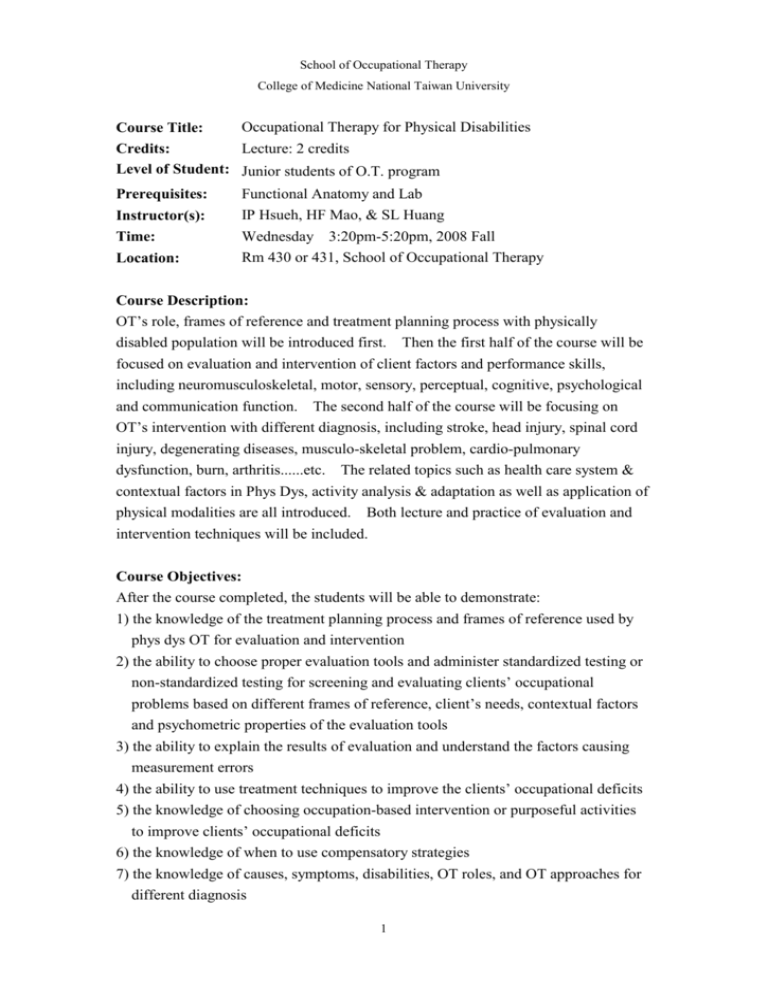
School of Occupational Therapy College of Medicine National Taiwan University Occupational Therapy for Physical Disabilities Course Title: Lecture: 2 credits Credits: Level of Student: Junior students of O.T. program Prerequisites: Instructor(s): Time: Location: Functional Anatomy and Lab IP Hsueh, HF Mao, & SL Huang Wednesday 3:20pm-5:20pm, 2008 Fall Rm 430 or 431, School of Occupational Therapy Course Description: OT’s role, frames of reference and treatment planning process with physically disabled population will be introduced first. Then the first half of the course will be focused on evaluation and intervention of client factors and performance skills, including neuromusculoskeletal, motor, sensory, perceptual, cognitive, psychological and communication function. The second half of the course will be focusing on OT’s intervention with different diagnosis, including stroke, head injury, spinal cord injury, degenerating diseases, musculo-skeletal problem, cardio-pulmonary dysfunction, burn, arthritis......etc. The related topics such as health care system & contextual factors in Phys Dys, activity analysis & adaptation as well as application of physical modalities are all introduced. Both lecture and practice of evaluation and intervention techniques will be included. Course Objectives: After the course completed, the students will be able to demonstrate: 1) the knowledge of the treatment planning process and frames of reference used by phys dys OT for evaluation and intervention 2) the ability to choose proper evaluation tools and administer standardized testing or non-standardized testing for screening and evaluating clients’ occupational problems based on different frames of reference, client’s needs, contextual factors and psychometric properties of the evaluation tools 3) the ability to explain the results of evaluation and understand the factors causing measurement errors 4) the ability to use treatment techniques to improve the clients’ occupational deficits 5) the knowledge of choosing occupation-based intervention or purposeful activities to improve clients’ occupational deficits 6) the knowledge of when to use compensatory strategies 7) the knowledge of causes, symptoms, disabilities, OT roles, and OT approaches for different diagnosis 1 School of Occupational Therapy College of Medicine National Taiwan University Schedule of the Course: Date Topics Instructor 9/17 W3 Introduction to the course Framework for OT in Phys Dys & Treatment Planning Process Hsueh, IP 9/24 W3 Professional Procedures for Neuromuscular Dysfunction—Range of Motion Problems I Hsueh, IP 10/01 W3 Professional Procedures for Neuromuscular Dysfunction—Muscle Tone Problems Hsueh, IP 10/08 W3 Professional Procedures for Neuromuscular Dysfunction—Muscle strength & Endurance Deficits Hsueh, IP 10/15 W3 Professional Procedures for Process Skills Dysfunction--Coordination Problems Mao, HF 10/22 W3 Professional Procedures for Process Skills Dysfunction--Postural Control Problems Mao, HF 10/29 W3 Professional Procedures for Process Skills Dysfunction--Sensory Dysfunction Hsueh, IP 11/05 W3 Professional Procedures for Visual-Perceptual Dysfunction Hsueh, IP 11/12 W3 Midterm examination Hsueh, IP 11/19 W3 Professional Procedures for Cognitive Dysfunction Hsueh, IP 11/26 W3 Introduction of Swallowing Problems & Acquired Speech/ Language Disorders Lin, YY(ST) 12/03 W3 Activity Analysis & Adaptation Hsueh, IP 12/10 W3 OT for Burned OT for SCI Huang, SL Hsueh, IP 12/17 W3 OT for CVA & HI Hsueh, IP 12/24 W3 OT for Cardio-pulmonary Conditions & Arthritic Mao, HF Population 12/31 W3 OT for Degenerating Disease, AIDS & Cancer Hsueh, IP 1/07 W3 OT for Orthopedic Conditions Health Care System & Regulatory Issues in Phys Dys Mao, HF 1/14 W3 Final examination-lecture Hsueh, IP Grading: 2 School of Occupational Therapy College of Medicine National Taiwan University Midterm Final Participation* 40% 40% 20% *Participation: attendance, punctuality, concentration, participation in group discussion and practice, assignment reporting, questioning...... References: 1. Occupational Therapy for Physical Dysfunction, 6th Ed, Trombly, CA. Lippincott Williams & Wilkins, 2007. 2. Occupational Therapy: Practice Skills for Physical Dysfunction, 6th Ed., Pedretti, LW. Mosby, 2007 Other references will be assigned in each class 3


